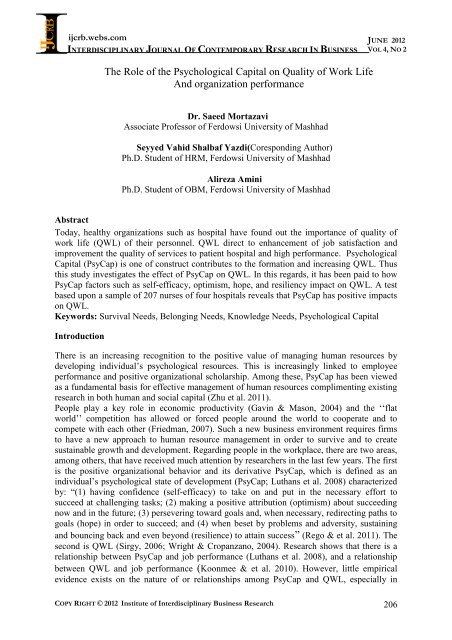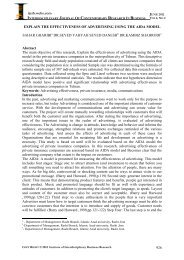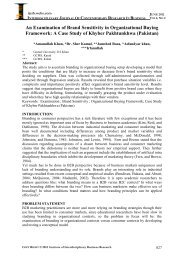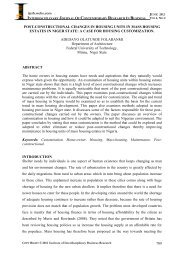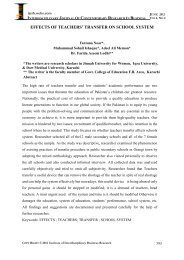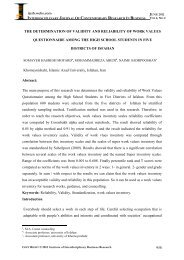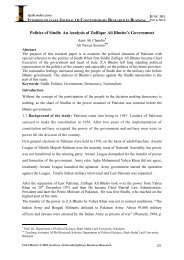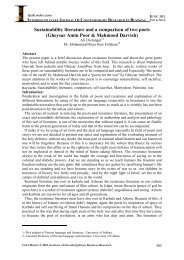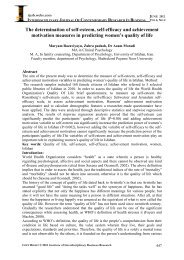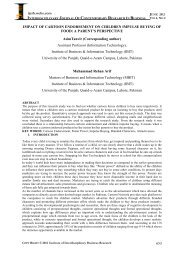The Role of the Psychological Capital on Quality of Work Life And ...
The Role of the Psychological Capital on Quality of Work Life And ...
The Role of the Psychological Capital on Quality of Work Life And ...
You also want an ePaper? Increase the reach of your titles
YUMPU automatically turns print PDFs into web optimized ePapers that Google loves.
ijcrb.webs.com<br />
INTERDISCIPLINARY JOURNAL OF CONTEMPORARY RESEARCH IN BUSINESS<br />
<str<strong>on</strong>g>The</str<strong>on</strong>g> <str<strong>on</strong>g>Role</str<strong>on</strong>g> <str<strong>on</strong>g>of</str<strong>on</strong>g> <str<strong>on</strong>g>the</str<strong>on</strong>g> <str<strong>on</strong>g>Psychological</str<strong>on</strong>g> <str<strong>on</strong>g>Capital</str<strong>on</strong>g> <strong>on</strong> <strong>Quality</strong> <str<strong>on</strong>g>of</str<strong>on</strong>g> <strong>Work</strong> <strong>Life</strong><br />
<strong>And</strong> organizati<strong>on</strong> performance<br />
Dr. Saeed Mortazavi<br />
Associate Pr<str<strong>on</strong>g>of</str<strong>on</strong>g>essor <str<strong>on</strong>g>of</str<strong>on</strong>g> Ferdowsi University <str<strong>on</strong>g>of</str<strong>on</strong>g> Mashhad<br />
Seyyed Vahid Shalbaf Yazdi(Coresp<strong>on</strong>ding Author)<br />
Ph.D. Student <str<strong>on</strong>g>of</str<strong>on</strong>g> HRM, Ferdowsi University <str<strong>on</strong>g>of</str<strong>on</strong>g> Mashhad<br />
Alireza Amini<br />
Ph.D. Student <str<strong>on</strong>g>of</str<strong>on</strong>g> OBM, Ferdowsi University <str<strong>on</strong>g>of</str<strong>on</strong>g> Mashhad<br />
COPY RIGHT © 2012 Institute <str<strong>on</strong>g>of</str<strong>on</strong>g> Interdisciplinary Business Research<br />
JUNE 2012<br />
VOL 4, NO 2<br />
Abstract<br />
Today, healthy organizati<strong>on</strong>s such as hospital have found out <str<strong>on</strong>g>the</str<strong>on</strong>g> importance <str<strong>on</strong>g>of</str<strong>on</strong>g> quality <str<strong>on</strong>g>of</str<strong>on</strong>g><br />
work life (QWL) <str<strong>on</strong>g>of</str<strong>on</strong>g> <str<strong>on</strong>g>the</str<strong>on</strong>g>ir pers<strong>on</strong>nel. QWL direct to enhancement <str<strong>on</strong>g>of</str<strong>on</strong>g> job satisfacti<strong>on</strong> and<br />
improvement <str<strong>on</strong>g>the</str<strong>on</strong>g> quality <str<strong>on</strong>g>of</str<strong>on</strong>g> services to patient hospital and high performance. <str<strong>on</strong>g>Psychological</str<strong>on</strong>g><br />
<str<strong>on</strong>g>Capital</str<strong>on</strong>g> (PsyCap) is <strong>on</strong>e <str<strong>on</strong>g>of</str<strong>on</strong>g> c<strong>on</strong>struct c<strong>on</strong>tributes to <str<strong>on</strong>g>the</str<strong>on</strong>g> formati<strong>on</strong> and increasing QWL. Thus<br />
this study investigates <str<strong>on</strong>g>the</str<strong>on</strong>g> effect <str<strong>on</strong>g>of</str<strong>on</strong>g> PsyCap <strong>on</strong> QWL. In this regards, it has been paid to how<br />
PsyCap factors such as self-efficacy, optimism, hope, and resiliency impact <strong>on</strong> QWL. A test<br />
based up<strong>on</strong> a sample <str<strong>on</strong>g>of</str<strong>on</strong>g> 207 nurses <str<strong>on</strong>g>of</str<strong>on</strong>g> four hospitals reveals that PsyCap has positive impacts<br />
<strong>on</strong> QWL.<br />
Keywords: Survival Needs, Bel<strong>on</strong>ging Needs, Knowledge Needs, <str<strong>on</strong>g>Psychological</str<strong>on</strong>g> <str<strong>on</strong>g>Capital</str<strong>on</strong>g><br />
Introducti<strong>on</strong><br />
<str<strong>on</strong>g>The</str<strong>on</strong>g>re is an increasing recogniti<strong>on</strong> to <str<strong>on</strong>g>the</str<strong>on</strong>g> positive value <str<strong>on</strong>g>of</str<strong>on</strong>g> managing human resources by<br />
developing individual’s psychological resources. This is increasingly linked to employee<br />
performance and positive organizati<strong>on</strong>al scholarship. Am<strong>on</strong>g <str<strong>on</strong>g>the</str<strong>on</strong>g>se, PsyCap has been viewed<br />
as a fundamental basis for effective management <str<strong>on</strong>g>of</str<strong>on</strong>g> human resources complimenting existing<br />
research in both human and social capital (Zhu et al. 2011).<br />
People play a key role in ec<strong>on</strong>omic productivity (Gavin & Mas<strong>on</strong>, 2004) and <str<strong>on</strong>g>the</str<strong>on</strong>g> ‘‘flat<br />
world’’ competiti<strong>on</strong> has allowed or forced people around <str<strong>on</strong>g>the</str<strong>on</strong>g> world to cooperate and to<br />
compete with each o<str<strong>on</strong>g>the</str<strong>on</strong>g>r (Friedman, 2007). Such a new business envir<strong>on</strong>ment requires firms<br />
to have a new approach to human resource management in order to survive and to create<br />
sustainable growth and development. Regarding people in <str<strong>on</strong>g>the</str<strong>on</strong>g> workplace, <str<strong>on</strong>g>the</str<strong>on</strong>g>re are two areas,<br />
am<strong>on</strong>g o<str<strong>on</strong>g>the</str<strong>on</strong>g>rs, that have received much attenti<strong>on</strong> by researchers in <str<strong>on</strong>g>the</str<strong>on</strong>g> last few years. <str<strong>on</strong>g>The</str<strong>on</strong>g> first<br />
is <str<strong>on</strong>g>the</str<strong>on</strong>g> positive organizati<strong>on</strong>al behavior and its derivative PsyCap, which is defined as an<br />
individual’s psychological state <str<strong>on</strong>g>of</str<strong>on</strong>g> development (PsyCap; Luthans et al. 2008) characterized<br />
by: “(1) having c<strong>on</strong>fidence (self-efficacy) to take <strong>on</strong> and put in <str<strong>on</strong>g>the</str<strong>on</strong>g> necessary effort to<br />
succeed at challenging tasks; (2) making a positive attributi<strong>on</strong> (optimism) about succeeding<br />
now and in <str<strong>on</strong>g>the</str<strong>on</strong>g> future; (3) persevering toward goals and, when necessary, redirecting paths to<br />
goals (hope) in order to succeed; and (4) when beset by problems and adversity, sustaining<br />
and bouncing back and even bey<strong>on</strong>d (resilience) to attain success” (Rego & et al. 2011). <str<strong>on</strong>g>The</str<strong>on</strong>g><br />
sec<strong>on</strong>d is QWL (Sirgy, 2006; Wright & Cropanzano, 2004). Research shows that <str<strong>on</strong>g>the</str<strong>on</strong>g>re is a<br />
relati<strong>on</strong>ship between PsyCap and job performance (Luthans et al. 2008), and a relati<strong>on</strong>ship<br />
between QWL and job performance )Ko<strong>on</strong>mee & et al. 2010). However, little empirical<br />
evidence exists <strong>on</strong> <str<strong>on</strong>g>the</str<strong>on</strong>g> nature <str<strong>on</strong>g>of</str<strong>on</strong>g> or relati<strong>on</strong>ships am<strong>on</strong>g PsyCap and QWL, especially in<br />
206
ijcrb.webs.com<br />
INTERDISCIPLINARY JOURNAL OF CONTEMPORARY RESEARCH IN BUSINESS<br />
COPY RIGHT © 2012 Institute <str<strong>on</strong>g>of</str<strong>on</strong>g> Interdisciplinary Business Research<br />
JUNE 2012<br />
VOL 4, NO 2<br />
health care organizati<strong>on</strong>s such as Hospitals. Fur<str<strong>on</strong>g>the</str<strong>on</strong>g>rmore, to <str<strong>on</strong>g>the</str<strong>on</strong>g> best <str<strong>on</strong>g>of</str<strong>on</strong>g> our knowledge, little<br />
attenti<strong>on</strong> has been paid to <str<strong>on</strong>g>the</str<strong>on</strong>g> role <str<strong>on</strong>g>of</str<strong>on</strong>g> PsyCap in QWL and Job Performance. Thus, <str<strong>on</strong>g>the</str<strong>on</strong>g><br />
purpose <str<strong>on</strong>g>of</str<strong>on</strong>g> this study is to investigate <str<strong>on</strong>g>the</str<strong>on</strong>g> roles <str<strong>on</strong>g>of</str<strong>on</strong>g> PsyCap in job performance and QWL in<br />
private and public Hospitals <str<strong>on</strong>g>of</str<strong>on</strong>g> Mashhad city.<br />
Background and Research Hypo<str<strong>on</strong>g>the</str<strong>on</strong>g>ses<br />
Fig.1 depicts a c<strong>on</strong>ceptual model explaining <str<strong>on</strong>g>the</str<strong>on</strong>g> role <str<strong>on</strong>g>of</str<strong>on</strong>g> PsyCap in QWL and subsequently in<br />
job performance.<br />
1. <strong>Quality</strong> <str<strong>on</strong>g>of</str<strong>on</strong>g> <strong>Work</strong> life (QWL):<br />
QWL is defined as “employee satisfacti<strong>on</strong> with a variety <str<strong>on</strong>g>of</str<strong>on</strong>g> needs through resources,<br />
activities, and outcomes stemming from participati<strong>on</strong> in <str<strong>on</strong>g>the</str<strong>on</strong>g> workplace” (Sirgy & et al. 2001)<br />
.Studies dem<strong>on</strong>strate that employees with high QWL tend to report high levels <str<strong>on</strong>g>of</str<strong>on</strong>g><br />
identificati<strong>on</strong> with <str<strong>on</strong>g>the</str<strong>on</strong>g>ir organizati<strong>on</strong>s, job satisfacti<strong>on</strong>, job performance and lower levels <str<strong>on</strong>g>of</str<strong>on</strong>g><br />
turnover and pers<strong>on</strong>al alienati<strong>on</strong> (e.g., Efraty, Sirgy & Claiborne, 1991). One<br />
c<strong>on</strong>ceptualizati<strong>on</strong> <str<strong>on</strong>g>of</str<strong>on</strong>g> QWL, based <strong>on</strong> need-hierarchy <str<strong>on</strong>g>the</str<strong>on</strong>g>ory <str<strong>on</strong>g>of</str<strong>on</strong>g> Maslow, regards QWL as<br />
employee satisfacti<strong>on</strong> <str<strong>on</strong>g>of</str<strong>on</strong>g> seven sets <str<strong>on</strong>g>of</str<strong>on</strong>g> human developmental needs: (1) health and safety<br />
needs, (2) ec<strong>on</strong>omic and family needs, (3) social needs, (4) esteem needs, (5) actualizati<strong>on</strong><br />
needs, (6) knowledge needs, and (7) es<str<strong>on</strong>g>the</str<strong>on</strong>g>tic needs (Marta & et al, 2011).<br />
QWL was c<strong>on</strong>ceptualized in terms <str<strong>on</strong>g>of</str<strong>on</strong>g> need satisfacti<strong>on</strong> stemming from an interacti<strong>on</strong> <str<strong>on</strong>g>of</str<strong>on</strong>g><br />
workers' needs (survival, social, ego, and self-actualizati<strong>on</strong> needs) and those organizati<strong>on</strong>al<br />
resources relevant for meeting <str<strong>on</strong>g>the</str<strong>on</strong>g>m. Robbins (1989) defined QWL as "a process by which an<br />
organizati<strong>on</strong> resp<strong>on</strong>ds to employee needs by developing mechanisms to allow <str<strong>on</strong>g>the</str<strong>on</strong>g>m to share<br />
fully in making <str<strong>on</strong>g>the</str<strong>on</strong>g> decisi<strong>on</strong>s that design <str<strong>on</strong>g>the</str<strong>on</strong>g>ir lives at work. According to QWL is a<br />
philosophy, a set <str<strong>on</strong>g>of</str<strong>on</strong>g> principles, which holds that people are <str<strong>on</strong>g>the</str<strong>on</strong>g> most important resource in <str<strong>on</strong>g>the</str<strong>on</strong>g><br />
organizati<strong>on</strong> as <str<strong>on</strong>g>the</str<strong>on</strong>g>y are trustworthy, resp<strong>on</strong>sible and capable <str<strong>on</strong>g>of</str<strong>on</strong>g> making valuable c<strong>on</strong>tributi<strong>on</strong><br />
and <str<strong>on</strong>g>the</str<strong>on</strong>g>y should be treated with dignity and respect.<br />
QWL has been well recognized as a multi-dimensi<strong>on</strong>al c<strong>on</strong>struct and it may not be universal<br />
or eternal. Beauregard (2007) said that <str<strong>on</strong>g>the</str<strong>on</strong>g> key c<strong>on</strong>cepts captured and discussed in <str<strong>on</strong>g>the</str<strong>on</strong>g><br />
existing literature include job security, better reward systems, higher pay, opportunity for<br />
growth, participative groups, and increased organizati<strong>on</strong>al productivity. In <str<strong>on</strong>g>the</str<strong>on</strong>g> scientific<br />
management traditi<strong>on</strong>, satisfacti<strong>on</strong> with QWL was thought to be based solely <strong>on</strong> "extrinsic"<br />
traits <str<strong>on</strong>g>of</str<strong>on</strong>g> <str<strong>on</strong>g>the</str<strong>on</strong>g> job: salaries and o<str<strong>on</strong>g>the</str<strong>on</strong>g>r tangible benefits, and <str<strong>on</strong>g>the</str<strong>on</strong>g> safety and hygiene <str<strong>on</strong>g>of</str<strong>on</strong>g> <str<strong>on</strong>g>the</str<strong>on</strong>g><br />
workplace. By c<strong>on</strong>trast, <str<strong>on</strong>g>the</str<strong>on</strong>g> human relati<strong>on</strong>s approach stresses that, while extrinsic rewards<br />
are important, "intrinsic rewards" are key predictors <str<strong>on</strong>g>of</str<strong>on</strong>g> productivity, efficiency, absenteeism<br />
and turnover. <str<strong>on</strong>g>The</str<strong>on</strong>g>se intrinsic rewards include traits specific to <str<strong>on</strong>g>the</str<strong>on</strong>g> work d<strong>on</strong>e, <str<strong>on</strong>g>the</str<strong>on</strong>g> "task<br />
c<strong>on</strong>tent": skill levels, aut<strong>on</strong>omy and challenge.<br />
According Robbins QWL is “a process by which an organizati<strong>on</strong> resp<strong>on</strong>ds to employee needs<br />
by developing mechanisms to allow <str<strong>on</strong>g>the</str<strong>on</strong>g>m to share fully in making <str<strong>on</strong>g>the</str<strong>on</strong>g> decisi<strong>on</strong>s that design<br />
<str<strong>on</strong>g>the</str<strong>on</strong>g>ir lives at work”. <str<strong>on</strong>g>The</str<strong>on</strong>g> key elements <str<strong>on</strong>g>of</str<strong>on</strong>g> QWL in <str<strong>on</strong>g>the</str<strong>on</strong>g> literature include job security, job<br />
satisfacti<strong>on</strong>, better reward system, employee benefits, employee involvement and<br />
organizati<strong>on</strong>al performance (Havlovic, 1991). For <str<strong>on</strong>g>the</str<strong>on</strong>g> purpose <str<strong>on</strong>g>of</str<strong>on</strong>g> this study, QWL is defined<br />
as <str<strong>on</strong>g>the</str<strong>on</strong>g> favorable c<strong>on</strong>diti<strong>on</strong> and envir<strong>on</strong>ment <str<strong>on</strong>g>of</str<strong>on</strong>g> employees benefit, employees’ welfare and<br />
management attitudes towards operati<strong>on</strong>al workers as well as employees in general.<br />
<str<strong>on</strong>g>The</str<strong>on</strong>g>re is a plethora <str<strong>on</strong>g>of</str<strong>on</strong>g> literature highlighting <str<strong>on</strong>g>the</str<strong>on</strong>g> factors critical for <str<strong>on</strong>g>the</str<strong>on</strong>g> assessment <str<strong>on</strong>g>of</str<strong>on</strong>g> QWL<br />
(Srinivas, 1994). Attempts also have been made to empirically define QWL (Levine et al.,<br />
1984; Mirvis & Lawler, 1984; Walt<strong>on</strong>, 1974). Comprehensive delineati<strong>on</strong> <str<strong>on</strong>g>of</str<strong>on</strong>g> <str<strong>on</strong>g>the</str<strong>on</strong>g> QWL<br />
c<strong>on</strong>cept is found in three major works: Levine et al. (1984), and Walt<strong>on</strong> (1974). O<str<strong>on</strong>g>the</str<strong>on</strong>g>r<br />
207
ijcrb.webs.com<br />
INTERDISCIPLINARY JOURNAL OF CONTEMPORARY RESEARCH IN BUSINESS<br />
COPY RIGHT © 2012 Institute <str<strong>on</strong>g>of</str<strong>on</strong>g> Interdisciplinary Business Research<br />
JUNE 2012<br />
VOL 4, NO 2<br />
researchers have attempted to measure QWL in a variety <str<strong>on</strong>g>of</str<strong>on</strong>g> settings using combinati<strong>on</strong>s <str<strong>on</strong>g>of</str<strong>on</strong>g><br />
various questi<strong>on</strong>naires such as job satisfacti<strong>on</strong>, organizati<strong>on</strong>al commitment, alienati<strong>on</strong>, job<br />
stress, organizati<strong>on</strong>al identificati<strong>on</strong>, job involvement and finally work role ambiguity,<br />
c<strong>on</strong>flict, and overload were studied as proxy measures <str<strong>on</strong>g>of</str<strong>on</strong>g> QWL.<br />
<str<strong>on</strong>g>The</str<strong>on</strong>g>re appeared to be no <strong>on</strong>e comm<strong>on</strong>ly accepted definiti<strong>on</strong> for quality <str<strong>on</strong>g>of</str<strong>on</strong>g> work life. Heskett,<br />
Sasser and Schlesinger (1997) proposed that QWL, which was measured by <str<strong>on</strong>g>the</str<strong>on</strong>g> feelings that<br />
employees have towards <str<strong>on</strong>g>the</str<strong>on</strong>g>ir jobs, colleagues, and companies would enhance a chain effect<br />
leading to organizati<strong>on</strong>’s growth and pr<str<strong>on</strong>g>of</str<strong>on</strong>g>itability. According to Havlovic (1991), and Straw<br />
and Heckscher (1984), <str<strong>on</strong>g>the</str<strong>on</strong>g> key c<strong>on</strong>cepts captured in QWL include job security, better reward<br />
systems, higher pay, opportunity for growth, and participative groups am<strong>on</strong>g o<str<strong>on</strong>g>the</str<strong>on</strong>g>rs. Walt<strong>on</strong><br />
(1974) proposed <str<strong>on</strong>g>the</str<strong>on</strong>g> c<strong>on</strong>ceptual categories <str<strong>on</strong>g>of</str<strong>on</strong>g> QWL. He suggested eight aspects in which<br />
employees percepti<strong>on</strong>s towards <str<strong>on</strong>g>the</str<strong>on</strong>g>ir work organizati<strong>on</strong>s could determine <str<strong>on</strong>g>the</str<strong>on</strong>g>ir QWL:<br />
adequate and fair compensati<strong>on</strong>; safe and health envir<strong>on</strong>ment; development <str<strong>on</strong>g>of</str<strong>on</strong>g> human<br />
capacities; growth and security; social integrative c<strong>on</strong>stituti<strong>on</strong>alism; <str<strong>on</strong>g>the</str<strong>on</strong>g> total life space and<br />
social relevance.<br />
In UK, Gilgeous (1998) assessed how manufacturing managers perceived <str<strong>on</strong>g>the</str<strong>on</strong>g>ir QWL in five<br />
different industries. Despite <str<strong>on</strong>g>the</str<strong>on</strong>g> growing complexity <str<strong>on</strong>g>of</str<strong>on</strong>g> working life, Walt<strong>on</strong>’s (1974) eightpart<br />
typology <str<strong>on</strong>g>of</str<strong>on</strong>g> <str<strong>on</strong>g>the</str<strong>on</strong>g> dimensi<strong>on</strong>s <str<strong>on</strong>g>of</str<strong>on</strong>g> QWL remains a useful analytical tool.Using samples from<br />
Standard & Poors 500 companies, Lau (2000) found that QWL companies have a higher<br />
growth rate as measured by <str<strong>on</strong>g>the</str<strong>on</strong>g> five-year trends <str<strong>on</strong>g>of</str<strong>on</strong>g> sales growth and asset growth. However,<br />
<str<strong>on</strong>g>the</str<strong>on</strong>g> outcome for pr<str<strong>on</strong>g>of</str<strong>on</strong>g>itability yield mixed results <strong>on</strong> Walt<strong>on</strong>’s (1974) c<strong>on</strong>ceptualisati<strong>on</strong> <str<strong>on</strong>g>of</str<strong>on</strong>g><br />
QWL. Saklani (2004) stressed that with <str<strong>on</strong>g>the</str<strong>on</strong>g> ever-changing technology and increased access to<br />
informati<strong>on</strong>, <str<strong>on</strong>g>the</str<strong>on</strong>g> study <str<strong>on</strong>g>of</str<strong>on</strong>g> organizati<strong>on</strong>s with respect to productivity, efficiency and quality <str<strong>on</strong>g>of</str<strong>on</strong>g><br />
services very crucial in order to improve <str<strong>on</strong>g>the</str<strong>on</strong>g> performance <str<strong>on</strong>g>of</str<strong>on</strong>g> work in India. <str<strong>on</strong>g>The</str<strong>on</strong>g> need to<br />
improve organizati<strong>on</strong>al productivity in <str<strong>on</strong>g>the</str<strong>on</strong>g> health care industry has spurred Brooks and<br />
<strong>And</strong>ers<strong>on</strong> (2005) to develop <str<strong>on</strong>g>the</str<strong>on</strong>g> c<strong>on</strong>struct <str<strong>on</strong>g>of</str<strong>on</strong>g> quality <str<strong>on</strong>g>of</str<strong>on</strong>g> nursing work life. <str<strong>on</strong>g>The</str<strong>on</strong>g>y came out with<br />
four dimensi<strong>on</strong>s <str<strong>on</strong>g>of</str<strong>on</strong>g> <str<strong>on</strong>g>the</str<strong>on</strong>g> c<strong>on</strong>ceptual framework namely; work life/home life dimensi<strong>on</strong>, work<br />
design dimensi<strong>on</strong>, work c<strong>on</strong>text dimensi<strong>on</strong> and work world dimensi<strong>on</strong>. In ano<str<strong>on</strong>g>the</str<strong>on</strong>g>r study d<strong>on</strong>e<br />
by Wyatt and Chay (2001), <str<strong>on</strong>g>the</str<strong>on</strong>g>y found four dimensi<strong>on</strong>s <str<strong>on</strong>g>of</str<strong>on</strong>g> QWLam<strong>on</strong>g <str<strong>on</strong>g>the</str<strong>on</strong>g> predominantly<br />
Chinese Singapore sample <str<strong>on</strong>g>of</str<strong>on</strong>g> employees. In Malaysia, Hanefah & et al. (2003), designed,<br />
developed and tested QWL measure for pr<str<strong>on</strong>g>of</str<strong>on</strong>g>essi<strong>on</strong>als, namely public and government<br />
accountants and architects. <str<strong>on</strong>g>The</str<strong>on</strong>g>y c<strong>on</strong>ceptualized QWL as a multi-dimensi<strong>on</strong>al c<strong>on</strong>struct<br />
comprised <str<strong>on</strong>g>of</str<strong>on</strong>g> seven dimensi<strong>on</strong>s, namely growth and development, participati<strong>on</strong>, physical<br />
envir<strong>on</strong>ment, supervisi<strong>on</strong>, pay and benefits, social relevance and workplace integrati<strong>on</strong>. In<br />
summary, several studies that have examined QWL dimensi<strong>on</strong>s varied significantly not <strong>on</strong>ly<br />
across countries but also am<strong>on</strong>g researchers. This study was an attempt to fur<str<strong>on</strong>g>the</str<strong>on</strong>g>r develop <str<strong>on</strong>g>the</str<strong>on</strong>g><br />
dimensi<strong>on</strong>s <str<strong>on</strong>g>of</str<strong>on</strong>g> QWL in iran.<br />
<str<strong>on</strong>g>The</str<strong>on</strong>g>refore, according to what was discussed above, <str<strong>on</strong>g>the</str<strong>on</strong>g> first hypo<str<strong>on</strong>g>the</str<strong>on</strong>g>sis was proposed as<br />
following:<br />
H1: QWL has a positive impact <strong>on</strong> performance.<br />
2. <str<strong>on</strong>g>Psychological</str<strong>on</strong>g> <str<strong>on</strong>g>Capital</str<strong>on</strong>g> (PsyCap)<br />
C<strong>on</strong>cern about trait-like pers<strong>on</strong>ality and state-like psychological capacities <str<strong>on</strong>g>of</str<strong>on</strong>g> employees has<br />
received little attenti<strong>on</strong> by organizati<strong>on</strong>al behavior researchers. Trait-like pers<strong>on</strong>ality is not<br />
specific to any task or situati<strong>on</strong> and tends to be stable over time, whereas state-like<br />
psychological capacities are more specific to certain situati<strong>on</strong>s or tasks and tend to be more<br />
malleable over time (Chen & et al, 2000). Several related c<strong>on</strong>cepts that describe state-like<br />
psychological capacities <str<strong>on</strong>g>of</str<strong>on</strong>g> employees can be found in <str<strong>on</strong>g>the</str<strong>on</strong>g> literature <strong>on</strong> positive<br />
208
ijcrb.webs.com<br />
INTERDISCIPLINARY JOURNAL OF CONTEMPORARY RESEARCH IN BUSINESS<br />
COPY RIGHT © 2012 Institute <str<strong>on</strong>g>of</str<strong>on</strong>g> Interdisciplinary Business Research<br />
JUNE 2012<br />
VOL 4, NO 2<br />
organizati<strong>on</strong>al behavior such as psychological ownership (Avey & et al, 2009), PsyCap<br />
(Luthans & et al, 2008). This study focuses <strong>on</strong> PsyCap <str<strong>on</strong>g>of</str<strong>on</strong>g> marketers.<br />
Luthans (2004) defines PsyCap as “a core psychological factor <str<strong>on</strong>g>of</str<strong>on</strong>g> positivity in general, and<br />
POB criteria meeting states in particular, that go bey<strong>on</strong>d human and social capital to gain a<br />
competitive advantage through investment development <str<strong>on</strong>g>of</str<strong>on</strong>g> “who you are”. He points out <str<strong>on</strong>g>the</str<strong>on</strong>g><br />
PsyCap are: (a)based <strong>on</strong> <str<strong>on</strong>g>the</str<strong>on</strong>g> positive psychological paradigm; (b)include psychological states<br />
based <strong>on</strong> positive organizati<strong>on</strong>al behavior or POB criteria; (c) goes bey<strong>on</strong>d human capital and<br />
social capital; (d)involves investment and development for a return yielding performance<br />
improvement and resulting competitive advantage (Luthans,2005). <str<strong>on</strong>g>The</str<strong>on</strong>g>re are four states<br />
c<strong>on</strong>tribute to PsyCap, with a return <str<strong>on</strong>g>of</str<strong>on</strong>g> improved performance such as higher productivity,<br />
better customer service, and more employee retenti<strong>on</strong>.<br />
(1)Self-efficacy, Stajkovic and Luthans (1998) define self-efficacy as <str<strong>on</strong>g>the</str<strong>on</strong>g> “individual’s<br />
c<strong>on</strong>victi<strong>on</strong>…about his or her abilities to mobilize <str<strong>on</strong>g>the</str<strong>on</strong>g> motivati<strong>on</strong>, cognitive resources, and<br />
courses <str<strong>on</strong>g>of</str<strong>on</strong>g> acti<strong>on</strong> needed to successfully execute a specific task within a given c<strong>on</strong>text”.<br />
(2)Hope, Snyder et al. (2002) defines it precisely as “a positive motivati<strong>on</strong>al state that is<br />
based <strong>on</strong> an interactively derived sense <str<strong>on</strong>g>of</str<strong>on</strong>g> successful (a) agency (goal-oriented energy) and<br />
(b) pathways (planning to meet goals).”<br />
(3)Optimism, like hope, optimism is a comm<strong>on</strong>ly used term, but Seligman’s (2002) definiti<strong>on</strong><br />
draws from attributi<strong>on</strong> <str<strong>on</strong>g>the</str<strong>on</strong>g>ory in terms <str<strong>on</strong>g>of</str<strong>on</strong>g> two crucial dimensi<strong>on</strong>s <str<strong>on</strong>g>of</str<strong>on</strong>g> <strong>on</strong>e’s explanatory style <str<strong>on</strong>g>of</str<strong>on</strong>g><br />
good and bad events: permanence and pervasiveness.<br />
(4)Resilience, According to Coutu (2002), <str<strong>on</strong>g>the</str<strong>on</strong>g> comm<strong>on</strong> <str<strong>on</strong>g>the</str<strong>on</strong>g>mes/pr<str<strong>on</strong>g>of</str<strong>on</strong>g>iles <str<strong>on</strong>g>of</str<strong>on</strong>g> resilient people are<br />
now recognized to be (a) a staunch acceptance <str<strong>on</strong>g>of</str<strong>on</strong>g> reality, (b) a deep belief, <str<strong>on</strong>g>of</str<strong>on</strong>g>ten buttressed by<br />
str<strong>on</strong>gly held values, that life is meaningful, and )c) an uncanny ability to improvise and<br />
adapt to significant change.(Meng & et al. 2011)<br />
PsyCap can vary within individuals <strong>on</strong> <str<strong>on</strong>g>the</str<strong>on</strong>g> basis <str<strong>on</strong>g>of</str<strong>on</strong>g> c<strong>on</strong>textual c<strong>on</strong>diti<strong>on</strong>s (e.g., an<br />
inspirati<strong>on</strong>al leader ( and individual characteristics (e.g., traits, physical health; for a detailed<br />
review <str<strong>on</strong>g>of</str<strong>on</strong>g> <str<strong>on</strong>g>the</str<strong>on</strong>g> state like nature <str<strong>on</strong>g>of</str<strong>on</strong>g> PsyCap, see Luthans et al., 2007). To date, PsyCap has been<br />
c<strong>on</strong>ceptually linked to work outcomes such as performance and extra role behaviors (e.g,.<br />
Luthans, 2002a, 2002b; Wright, 2003). In additi<strong>on</strong>, Luthans et al. (2007) presented<br />
psychometric support for a newly developed measure <str<strong>on</strong>g>of</str<strong>on</strong>g> PsyCap, as well as initial predictive<br />
validity evidence, by relating PsyCap to job performance and satisfacti<strong>on</strong> in two samples (for<br />
similar findings, see Youssef & Luthans, 2007), More recently, Avey, Wernsing & Luthans<br />
(2008) found that employees with higher levels <str<strong>on</strong>g>of</str<strong>on</strong>g> PsyCap experienced more positive<br />
emoti<strong>on</strong>s, which were in turn related to <str<strong>on</strong>g>the</str<strong>on</strong>g>ir engagement and cynicism during organizati<strong>on</strong>al<br />
change. <str<strong>on</strong>g>The</str<strong>on</strong>g>se authors also found that positive emoti<strong>on</strong>s mediated <str<strong>on</strong>g>the</str<strong>on</strong>g> relati<strong>on</strong>ship between<br />
employees’ PsyCap and <str<strong>on</strong>g>the</str<strong>on</strong>g>ir behavior, such as organizati<strong>on</strong>al citizenship behaviors and<br />
deviance. Fur<str<strong>on</strong>g>the</str<strong>on</strong>g>rmore, Luthans, Avey, Clapp-Smith & Li (2008) dem<strong>on</strong>strated <str<strong>on</strong>g>the</str<strong>on</strong>g><br />
usefulness <str<strong>on</strong>g>of</str<strong>on</strong>g> PsyCap in a Chinese c<strong>on</strong>text for predicting employees’ performance, whereas<br />
o<str<strong>on</strong>g>the</str<strong>on</strong>g>rs (Avey, Patera & West, 2006) have dem<strong>on</strong>strated that PsyCap helped reduce<br />
absenteeism in a sample <str<strong>on</strong>g>of</str<strong>on</strong>g> high technology employees. Despite this emerging empirical<br />
work, Luthans et al. noted that much remains to be d<strong>on</strong>e, especially in examining not <strong>on</strong>ly <str<strong>on</strong>g>the</str<strong>on</strong>g><br />
effects <str<strong>on</strong>g>of</str<strong>on</strong>g> PsyCap, <strong>on</strong> a range <str<strong>on</strong>g>of</str<strong>on</strong>g> important work outcomes, but also its antecedents.<br />
Research shows that <str<strong>on</strong>g>the</str<strong>on</strong>g>se four comp<strong>on</strong>ents (self-efficacy, optimism, hope, and resiliency) <str<strong>on</strong>g>of</str<strong>on</strong>g><br />
PsyCap have positive relati<strong>on</strong>ships with performance, happiness, well-being, and satisfacti<strong>on</strong><br />
<str<strong>on</strong>g>of</str<strong>on</strong>g> workers. For example, self-efficacy has been found to have a positive impact <strong>on</strong><br />
performance (Stajkovic & Luthans, 1998; Legal & Meyer, 2009). Employees’ optimism is<br />
related to <str<strong>on</strong>g>the</str<strong>on</strong>g>ir performance, satisfacti<strong>on</strong>, and happiness (Youssef & Luthans, 2007). Hope is<br />
209
ijcrb.webs.com<br />
INTERDISCIPLINARY JOURNAL OF CONTEMPORARY RESEARCH IN BUSINESS<br />
COPY RIGHT © 2012 Institute <str<strong>on</strong>g>of</str<strong>on</strong>g> Interdisciplinary Business Research<br />
JUNE 2012<br />
VOL 4, NO 2<br />
related to employees’ performance, satisfacti<strong>on</strong>, happiness, and retenti<strong>on</strong> (Youssef &<br />
Luthans, 2007). Resiliency has a positive relati<strong>on</strong>ship with employee performance and<br />
happiness and satisfacti<strong>on</strong> (Youssef & Luthans, 2007). In sum, self-efficacy, optimism, hope<br />
and resiliency are related to <str<strong>on</strong>g>the</str<strong>on</strong>g> performance and QWL <str<strong>on</strong>g>of</str<strong>on</strong>g> employees ( Tho D. Nguyen et al.<br />
2011). <str<strong>on</strong>g>The</str<strong>on</strong>g>refore, sec<strong>on</strong>d and third hypo<str<strong>on</strong>g>the</str<strong>on</strong>g>sis was proposed as following:<br />
H2: PsyCap has a positive impact <strong>on</strong> performance.<br />
H3: PsyCap has a positive impact <strong>on</strong> QWL.<br />
PsyCap<br />
Self-Efficacy<br />
Optimism<br />
Hope<br />
Resiliency<br />
Performance<br />
QWL<br />
Survival Needs<br />
Bel<strong>on</strong>ging Needs<br />
Knowledge Needs<br />
Fig.1. Potential effects <str<strong>on</strong>g>of</str<strong>on</strong>g> PsyCap <strong>on</strong> QWL & Performance<br />
(Research C<strong>on</strong>ceptual Model).<br />
Methodology<br />
This is a cross-secti<strong>on</strong> survey which defining <str<strong>on</strong>g>the</str<strong>on</strong>g> impact <str<strong>on</strong>g>of</str<strong>on</strong>g> PsyCap <strong>on</strong><br />
spreading MMC in safety critical organizati<strong>on</strong>s such as hospitals. For assessing<br />
this impact, <str<strong>on</strong>g>the</str<strong>on</strong>g> questi<strong>on</strong>s <str<strong>on</strong>g>of</str<strong>on</strong>g> Nguyen's (2011) questi<strong>on</strong>arie has been adopted and<br />
a questi<strong>on</strong>arie was designed with items involve five-item Likert-type scale<br />
items. <str<strong>on</strong>g>The</str<strong>on</strong>g> results in Table 2 dem<strong>on</strong>strate that <str<strong>on</strong>g>the</str<strong>on</strong>g> measures used in <str<strong>on</strong>g>the</str<strong>on</strong>g> current<br />
study all exceed <str<strong>on</strong>g>the</str<strong>on</strong>g> comm<strong>on</strong>ly accepted standard <str<strong>on</strong>g>of</str<strong>on</strong>g> coefficient alpha 0.7 Note<br />
that this will <strong>on</strong>ly support our arguments for measure reliability. Totality,<br />
according to early sampling, <str<strong>on</strong>g>the</str<strong>on</strong>g> reliability <str<strong>on</strong>g>of</str<strong>on</strong>g> questi<strong>on</strong>arie was .842 that was a<br />
good reliability<br />
Statistical Populati<strong>on</strong>, sample size, sampling method<br />
Data was collected from nurses <str<strong>on</strong>g>of</str<strong>on</strong>g> four hospitals that voluntary participated in<br />
research plan in Mashhad city. Two hospitals were private and two hospitals<br />
were public. Sample size that was calculated by Gpower S<str<strong>on</strong>g>of</str<strong>on</strong>g>tware c<strong>on</strong>sisted <str<strong>on</strong>g>of</str<strong>on</strong>g><br />
207 nurses which were selected random sampling method from four centers.<br />
Data collecti<strong>on</strong> pursuited until attain 207 complete questi<strong>on</strong>aires. Ratio <str<strong>on</strong>g>of</str<strong>on</strong>g> each<br />
two parts was c<strong>on</strong>sidered equal.<br />
210
ijcrb.webs.com<br />
INTERDISCIPLINARY JOURNAL OF CONTEMPORARY RESEARCH IN BUSINESS<br />
Results<br />
COPY RIGHT © 2012 Institute <str<strong>on</strong>g>of</str<strong>on</strong>g> Interdisciplinary Business Research<br />
JUNE 2012<br />
VOL 4, NO 2<br />
Descriptive statistics<br />
53.6% <str<strong>on</strong>g>of</str<strong>on</strong>g> resp<strong>on</strong>ders were female and 46.1% was male. Mean age <str<strong>on</strong>g>of</str<strong>on</strong>g><br />
resp<strong>on</strong>dents was 34 years and mean <str<strong>on</strong>g>of</str<strong>on</strong>g> tenure were 9.85 years. Educati<strong>on</strong> <str<strong>on</strong>g>of</str<strong>on</strong>g><br />
resp<strong>on</strong>dents was 20.3% diploma and under, 68.6% high deploma and BSc,<br />
11.1% higher. <str<strong>on</strong>g>The</str<strong>on</strong>g>ir m<strong>on</strong>thly incomes was 25.2% 320$ and under, 57.5%<br />
between 320 and 640 Dollars, and 16.9% higer.<br />
Measure validity<br />
To test <str<strong>on</strong>g>the</str<strong>on</strong>g> c<strong>on</strong>struct validity <str<strong>on</strong>g>of</str<strong>on</strong>g> each scale, we c<strong>on</strong>ducted a c<strong>on</strong>firmatory factor<br />
analysis (CFA) and analyzed <str<strong>on</strong>g>the</str<strong>on</strong>g> covariance matrix using <str<strong>on</strong>g>the</str<strong>on</strong>g> maximum<br />
likelihood procedure <str<strong>on</strong>g>of</str<strong>on</strong>g> SpssAmos 20. <str<strong>on</strong>g>The</str<strong>on</strong>g> fit statistics <str<strong>on</strong>g>of</str<strong>on</strong>g> model; χ 2 = 216.344,<br />
df = 192 and PValue =.000; goodness- <str<strong>on</strong>g>of</str<strong>on</strong>g>-fit index [GFI] =0.928; comparative fit<br />
index [CFI] = 0.984; root mean square error <str<strong>on</strong>g>of</str<strong>on</strong>g> approximati<strong>on</strong> (RMSEA) = .025;<br />
corresp<strong>on</strong>d reas<strong>on</strong>ably well with those found in <str<strong>on</strong>g>the</str<strong>on</strong>g> literature.<br />
A. Efficacy .721 3.901 .486<br />
α Mean A B C D E F G<br />
B. Optimism .701 3.830 .126 .685<br />
C. Hope .728 3.985 .225 .254 .594<br />
D. Resiliency .743 3.704 .151 .158 .264 .605<br />
E. Survival Needs .723 2.712 .101 .173 .100 .080 .918<br />
F. Bel<strong>on</strong>ging Needs .720 2.903 .071 .138 .092 .111 .340 .593<br />
G. Knowledge Needs .819 3.108 .190 .134 .157 .063 .389 .324 1.043<br />
Table 2. Scale means, reliability, and inter-scale correlati<strong>on</strong>s<br />
Structural Equati<strong>on</strong> Model<br />
<str<strong>on</strong>g>The</str<strong>on</strong>g> research hypo<str<strong>on</strong>g>the</str<strong>on</strong>g>ses were tested and relatioships between c<strong>on</strong>structs were<br />
modelling by using structural equati<strong>on</strong> analyses (hereafter referred to as SEM)<br />
with <str<strong>on</strong>g>the</str<strong>on</strong>g> maximum likelihood estimati<strong>on</strong> method using SpssAmos 20.<br />
Covariance matrices were analyzed in all cases using Amos. In this model, Selfefficacy,<br />
Optimism, Hope, Resiliency, Survival Needs, Bel<strong>on</strong>ging Needs and<br />
Knowledge Needs are treated as exogenous variables and PsyCap and QWL are<br />
treated as endogenous varaiable. Table 2 show <str<strong>on</strong>g>the</str<strong>on</strong>g> Summary statistics and<br />
covariance matrix <str<strong>on</strong>g>of</str<strong>on</strong>g> model exogenous variables.<br />
<str<strong>on</strong>g>The</str<strong>on</strong>g> general c<strong>on</strong>clusi<strong>on</strong> was that <str<strong>on</strong>g>the</str<strong>on</strong>g> <str<strong>on</strong>g>the</str<strong>on</strong>g>orized model was a good fit to <str<strong>on</strong>g>the</str<strong>on</strong>g> data.<br />
As <str<strong>on</strong>g>the</str<strong>on</strong>g> fit indices—χ 2 = 56.953, df= 32, CFI=.941, GFI=.951, NFI=.878,<br />
AGFI=.916, RMR=.042, and RMSEA=.062 —we c<strong>on</strong>clude that <str<strong>on</strong>g>the</str<strong>on</strong>g> fit is<br />
acceptable. Fig. 2 shows <str<strong>on</strong>g>the</str<strong>on</strong>g> overall SEM results with each standardized<br />
<str<strong>on</strong>g>the</str<strong>on</strong>g>oretical path coefficient.<br />
211
ijcrb.webs.com<br />
INTERDISCIPLINARY JOURNAL OF CONTEMPORARY RESEARCH IN BUSINESS<br />
Figure 2: Results <str<strong>on</strong>g>of</str<strong>on</strong>g> Structure Equati<strong>on</strong> Modeling<br />
COPY RIGHT © 2012 Institute <str<strong>on</strong>g>of</str<strong>on</strong>g> Interdisciplinary Business Research<br />
JUNE 2012<br />
VOL 4, NO 2<br />
Table 3 shows <str<strong>on</strong>g>the</str<strong>on</strong>g> unstandardized estimates <str<strong>on</strong>g>of</str<strong>on</strong>g> <str<strong>on</strong>g>the</str<strong>on</strong>g> structural paths and result <str<strong>on</strong>g>of</str<strong>on</strong>g> examined<br />
hypo<str<strong>on</strong>g>the</str<strong>on</strong>g>ses and standardized effects between c<strong>on</strong>structs in <str<strong>on</strong>g>the</str<strong>on</strong>g> model.<br />
According to calculated SEM, <str<strong>on</strong>g>The</str<strong>on</strong>g> results reveal that first hypo<str<strong>on</strong>g>the</str<strong>on</strong>g>sis (H1) that predicted <str<strong>on</strong>g>the</str<strong>on</strong>g><br />
positive impact <str<strong>on</strong>g>of</str<strong>on</strong>g> QWL <strong>on</strong> performance was supported (β = .293, p = .005). <str<strong>on</strong>g>The</str<strong>on</strong>g>refore, when<br />
an organizati<strong>on</strong> such as hospital had enjoyed from high level <str<strong>on</strong>g>of</str<strong>on</strong>g> QWL, we would expect to<br />
see high Performance. <str<strong>on</strong>g>The</str<strong>on</strong>g> estimated structural path between PsyCap and performance was<br />
significant (β =.341, p =.002), thus Hypo<str<strong>on</strong>g>the</str<strong>on</strong>g>sis 2 (H2) was supported. Finally, PsyCap also<br />
c<strong>on</strong>tribute to QWL (β =.389, p =.000), <str<strong>on</strong>g>the</str<strong>on</strong>g>n third hypo<str<strong>on</strong>g>the</str<strong>on</strong>g>sis (H3) were supported too. In all<br />
examinati<strong>on</strong>, Error and c<strong>on</strong>fidence interval was respectively 5% and 95%.<br />
<str<strong>on</strong>g>The</str<strong>on</strong>g> results also indicate that PsyCap with .455 and .389 total effects play an essential role in<br />
predicting job performance and QWL <str<strong>on</strong>g>of</str<strong>on</strong>g> hospital nurses.<br />
Hypo<str<strong>on</strong>g>the</str<strong>on</strong>g>sis Structural Path T-Statistic P-Value Direct<br />
Effect<br />
Indirect<br />
Effect<br />
Total<br />
Effects<br />
H1 QWLPerformance 2.788 .005 .293 .000 .293<br />
H2 PsyCap Performance 3.165 .002 .341 .114 .455<br />
H3 PsyCap QWL 3.409 .000 .389 .000 .389<br />
Table 3. Unstandardized Structural Paths in <str<strong>on</strong>g>the</str<strong>on</strong>g> Model and Standardized Direct, Indirect and<br />
Total Effects between C<strong>on</strong>structs<br />
Discussi<strong>on</strong> and C<strong>on</strong>clusi<strong>on</strong><br />
According to importance <str<strong>on</strong>g>of</str<strong>on</strong>g> enhancement <str<strong>on</strong>g>of</str<strong>on</strong>g> QWL and job performance in organizati<strong>on</strong>s such<br />
as hospital, <strong>on</strong>e <str<strong>on</strong>g>of</str<strong>on</strong>g> <str<strong>on</strong>g>the</str<strong>on</strong>g> most important factors that plays positive role is PsyCap <str<strong>on</strong>g>of</str<strong>on</strong>g> human<br />
resource <str<strong>on</strong>g>of</str<strong>on</strong>g> that organizati<strong>on</strong>. <str<strong>on</strong>g>The</str<strong>on</strong>g>n, in this research, we pay to test this assumpti<strong>on</strong> until help<br />
212
ijcrb.webs.com<br />
INTERDISCIPLINARY JOURNAL OF CONTEMPORARY RESEARCH IN BUSINESS<br />
COPY RIGHT © 2012 Institute <str<strong>on</strong>g>of</str<strong>on</strong>g> Interdisciplinary Business Research<br />
JUNE 2012<br />
VOL 4, NO 2<br />
managers to invest <strong>on</strong> PsyCap <str<strong>on</strong>g>of</str<strong>on</strong>g> <str<strong>on</strong>g>the</str<strong>on</strong>g>ir organizati<strong>on</strong> and improve QWL and subsequence job<br />
performance <str<strong>on</strong>g>of</str<strong>on</strong>g> <str<strong>on</strong>g>the</str<strong>on</strong>g>ir pers<strong>on</strong>nel. As Mirkamali & Narenji Thani (2011) discus that Identifying<br />
<str<strong>on</strong>g>the</str<strong>on</strong>g> factors related to faculty QWL is <str<strong>on</strong>g>of</str<strong>on</strong>g> great importance, because it has positive and<br />
significant relati<strong>on</strong> with job satisfacti<strong>on</strong>. <str<strong>on</strong>g>The</str<strong>on</strong>g>refore, we can improve Job satisfacti<strong>on</strong> by<br />
changing and manipulating QWL factors, and thus move toward <str<strong>on</strong>g>the</str<strong>on</strong>g> development <str<strong>on</strong>g>of</str<strong>on</strong>g> <str<strong>on</strong>g>the</str<strong>on</strong>g><br />
organizati<strong>on</strong>.<br />
Woolf (2004) suggests few ways to help people to create a healthy and quality life in<br />
workplace. First, individual must create a pers<strong>on</strong>al visi<strong>on</strong> by articulating something to be<br />
accomplishing in career. Such visi<strong>on</strong> will set a target <str<strong>on</strong>g>of</str<strong>on</strong>g> where individual wants to be in life<br />
and must be prepared to make adjustment at any time. Employee need to be flexible and<br />
ready as life’s journey is all about twists and turns. It keeps employee focus and strives<br />
towards <str<strong>on</strong>g>the</str<strong>on</strong>g> visi<strong>on</strong> and when <str<strong>on</strong>g>the</str<strong>on</strong>g>y pull <str<strong>on</strong>g>of</str<strong>on</strong>g>f, it will be a meaningful accomplishment. Individual<br />
must not perplex real identity with role played at work. Let <str<strong>on</strong>g>the</str<strong>on</strong>g> visi<strong>on</strong> manifest who each<br />
individual really are. <str<strong>on</strong>g>Role</str<strong>on</strong>g>s play at work is intended for <str<strong>on</strong>g>the</str<strong>on</strong>g> work game. It does not replicate<br />
true identity. To guarantee job satisfacti<strong>on</strong>, employees must let <str<strong>on</strong>g>the</str<strong>on</strong>g>ir visi<strong>on</strong> lead <str<strong>on</strong>g>the</str<strong>on</strong>g>m. Third,<br />
individual must develop healthy pers<strong>on</strong>al habits by taking care <str<strong>on</strong>g>of</str<strong>on</strong>g> <str<strong>on</strong>g>the</str<strong>on</strong>g>ir body, mind and spirit<br />
to withstand all those challenges and pressures you face at work. Eating habits, sleeping<br />
routines and exercising will helps employees live a healthy life style and resilient enough to<br />
face anything coming. It helps employees to be positive and accept almost everything in a<br />
positive way (Optimism). In <str<strong>on</strong>g>the</str<strong>on</strong>g> all ways, PsyCap as reveal in its nature can c<strong>on</strong>tributi<strong>on</strong> to<br />
create a situati<strong>on</strong> that promote QWL. <str<strong>on</strong>g>The</str<strong>on</strong>g>se c<strong>on</strong>tributi<strong>on</strong>s can be provided base <strong>on</strong> this point<br />
that having a favorite level <str<strong>on</strong>g>of</str<strong>on</strong>g> PsyCap totality and in framework <str<strong>on</strong>g>of</str<strong>on</strong>g> its dimensi<strong>on</strong>s (e.g. selfefficacy,<br />
hope, and resilience) can provide situati<strong>on</strong> that pers<strong>on</strong>nel can provide needs <str<strong>on</strong>g>of</str<strong>on</strong>g><br />
survival, bel<strong>on</strong>ging and knowledge (i.e. QLW) and subsequence improve <str<strong>on</strong>g>the</str<strong>on</strong>g>ir performance<br />
in workplace, and subsequent create ascendancy <str<strong>on</strong>g>of</str<strong>on</strong>g> <str<strong>on</strong>g>the</str<strong>on</strong>g>ir organizati<strong>on</strong>. For example, an<br />
hopeful (as a element <str<strong>on</strong>g>of</str<strong>on</strong>g> PsyCap) employee can create a career visi<strong>on</strong> <str<strong>on</strong>g>of</str<strong>on</strong>g> where he/she wants<br />
to be in life or a resilient pers<strong>on</strong> make him/her flexible and withstand all those challenges and<br />
pressures you face at work.<br />
<str<strong>on</strong>g>The</str<strong>on</strong>g> findings <str<strong>on</strong>g>of</str<strong>on</strong>g> this study signal hospital to recruit, develop, and manage nurses who are<br />
generally higher in PsyCap. Research shows that PsyCap is a more state-like factor than<br />
pers<strong>on</strong>ality traits, that is, it is more open to be developed and managed (Luthans et al. 2008).<br />
<str<strong>on</strong>g>The</str<strong>on</strong>g>refore, recruiting nurses with high levels <str<strong>on</strong>g>of</str<strong>on</strong>g> PsyCap and establishing appropriate human<br />
resource policies and practice to fur<str<strong>on</strong>g>the</str<strong>on</strong>g>r develop nurses’ PsyCap (i.e., self-efficacy, optimism,<br />
hope, and resilience) are desirable for hospital. <strong>And</strong>, in so doing, hospitals could enhance <str<strong>on</strong>g>the</str<strong>on</strong>g><br />
performance <str<strong>on</strong>g>of</str<strong>on</strong>g> <str<strong>on</strong>g>the</str<strong>on</strong>g>ir nurses, leading to an increase in hospital performance. This also<br />
improves nurses’ QWL, which is a critical factor for productivity (Wright and Cropanzano<br />
2004).<br />
Limitati<strong>on</strong>s and Directi<strong>on</strong>s for Future Research<br />
This research focuses <strong>on</strong> <str<strong>on</strong>g>the</str<strong>on</strong>g> state-like comp<strong>on</strong>ents <str<strong>on</strong>g>of</str<strong>on</strong>g> psychological factors <str<strong>on</strong>g>of</str<strong>on</strong>g> people, that is,<br />
PsyCap. Incorporating trait-like comp<strong>on</strong>ents such as psychological hardiness, pers<strong>on</strong>ality <str<strong>on</strong>g>of</str<strong>on</strong>g><br />
pers<strong>on</strong>nel will provide fur<str<strong>on</strong>g>the</str<strong>on</strong>g>r insights into <str<strong>on</strong>g>the</str<strong>on</strong>g> role <str<strong>on</strong>g>of</str<strong>on</strong>g> psychological aspects <str<strong>on</strong>g>of</str<strong>on</strong>g> people in <str<strong>on</strong>g>the</str<strong>on</strong>g>ir<br />
effort for promoting QWL. This is also an appropriate area for future research.<br />
It need to accomplish subsequent research in o<str<strong>on</strong>g>the</str<strong>on</strong>g>r industries or similar industry or o<str<strong>on</strong>g>the</str<strong>on</strong>g>r<br />
treatment pers<strong>on</strong>nel than nurse until invigorate our hypo<str<strong>on</strong>g>the</str<strong>on</strong>g>sizes. Because c<strong>on</strong>firming <str<strong>on</strong>g>the</str<strong>on</strong>g>se<br />
results in o<str<strong>on</strong>g>the</str<strong>on</strong>g>r industrial setting can reinforce <str<strong>on</strong>g>the</str<strong>on</strong>g>m.<br />
213
ijcrb.webs.com<br />
INTERDISCIPLINARY JOURNAL OF CONTEMPORARY RESEARCH IN BUSINESS<br />
References<br />
COPY RIGHT © 2012 Institute <str<strong>on</strong>g>of</str<strong>on</strong>g> Interdisciplinary Business Research<br />
JUNE 2012<br />
VOL 4, NO 2<br />
Avey, J.B., Avolio, B.J., Crossley, C.D., & Luthans, F. (2009). <str<strong>on</strong>g>Psychological</str<strong>on</strong>g> Ownership:<br />
<str<strong>on</strong>g>The</str<strong>on</strong>g>oretical Extensi<strong>on</strong>s, Measurement and Relati<strong>on</strong> to <strong>Work</strong> Outcomes. Journal <str<strong>on</strong>g>of</str<strong>on</strong>g><br />
Organizati<strong>on</strong>al Behavior, 30 (2), 173-191.<br />
Avey, J.B., Patera, J.L., & West, B.J. (2006). Positive psychological capital: A new approach<br />
for understanding absenteeism. Journal <str<strong>on</strong>g>of</str<strong>on</strong>g> Leadership and Organizati<strong>on</strong>al Studies, 13(2), 42-<br />
60.<br />
Avey, J.B., Wernsing, T.S. & Luthans, F. (2008). Can positive employees help positive<br />
organizati<strong>on</strong>al change? Impact <str<strong>on</strong>g>of</str<strong>on</strong>g> psychological capital and emoti<strong>on</strong>s <strong>on</strong> relevant attitudes<br />
and behaviors. Journal <str<strong>on</strong>g>of</str<strong>on</strong>g> Applied Behavioral Science, 44, 48-70.<br />
Beauregard, T.A. (2007). Family Influences <strong>on</strong> <str<strong>on</strong>g>the</str<strong>on</strong>g> career life cycle. Career Choice in<br />
Mangement and Entrepreneurship: A Research Compani<strong>on</strong>. 101-126.<br />
Brooks, B.A., & <strong>And</strong>ers<strong>on</strong>, M.A. (2005). Defining quality <str<strong>on</strong>g>of</str<strong>on</strong>g> nursing work life. Nursing<br />
Ec<strong>on</strong>omics, 23 (6), 319 – 326.<br />
Chen, G., Stanley, M.G., Whiteman, J.A., & Kilcullen, R.N. (2000). Examinati<strong>on</strong> <str<strong>on</strong>g>of</str<strong>on</strong>g><br />
Relati<strong>on</strong>ships am<strong>on</strong>g Trait- Like Individual Differences, State-Like Individual Differences,<br />
and Learning Performance. Journal <str<strong>on</strong>g>of</str<strong>on</strong>g> Applied Psychology, 85 (6), 835-847.<br />
Efraty, D., Sirgy M.J., & Claiborne, C.B. (1991). <str<strong>on</strong>g>The</str<strong>on</strong>g> effects <str<strong>on</strong>g>of</str<strong>on</strong>g> pers<strong>on</strong>al alienati<strong>on</strong> <strong>on</strong><br />
organizati<strong>on</strong>al identificati<strong>on</strong>: a quality-<str<strong>on</strong>g>of</str<strong>on</strong>g>-work life model. J Bus Psychol, 6 (Fall), 57–78.<br />
Friedman, Thomas L. (2007). <str<strong>on</strong>g>The</str<strong>on</strong>g> World Is Flat: A Brief History <str<strong>on</strong>g>of</str<strong>on</strong>g> <str<strong>on</strong>g>the</str<strong>on</strong>g> Twenty-First Century.<br />
New York, NY: Farrar, Straus and Giroux.<br />
Gavin, J.H., & Mas<strong>on</strong>, R.O. (2004). <str<strong>on</strong>g>The</str<strong>on</strong>g> Virtuous Organizati<strong>on</strong>: <str<strong>on</strong>g>The</str<strong>on</strong>g> Value <str<strong>on</strong>g>of</str<strong>on</strong>g> Happiness in<br />
<str<strong>on</strong>g>the</str<strong>on</strong>g> <strong>Work</strong>place. Organizati<strong>on</strong>al Dynamics, 33 (4), 379-392.<br />
Gilgeous, V. (1998). Manufacturing managers: <str<strong>on</strong>g>the</str<strong>on</strong>g>ir quality <str<strong>on</strong>g>of</str<strong>on</strong>g> working life. Integrated<br />
Manufacturing Systems, 9 (3), 173-181.<br />
Hanefah, M., Zain, A.Y., Zain, R.M., & Ismail, H. (2003). <strong>Quality</strong> <str<strong>on</strong>g>of</str<strong>on</strong>g> work life and<br />
organizati<strong>on</strong>al commitment am<strong>on</strong>g Malaysian Public and Government Accountants.<br />
Malaysian Accounting Review, 2 (1).<br />
214
ijcrb.webs.com<br />
INTERDISCIPLINARY JOURNAL OF CONTEMPORARY RESEARCH IN BUSINESS<br />
COPY RIGHT © 2012 Institute <str<strong>on</strong>g>of</str<strong>on</strong>g> Interdisciplinary Business Research<br />
JUNE 2012<br />
VOL 4, NO 2<br />
Havlovic, S.J. (1991). <strong>Quality</strong> <str<strong>on</strong>g>of</str<strong>on</strong>g> work life and human resource outcomes. Industrial<br />
Relati<strong>on</strong>s, 30 (3), 469 - 479.<br />
Hian, C.C., & Einstein, W.O. (1990). <strong>Quality</strong> <str<strong>on</strong>g>of</str<strong>on</strong>g> work life (QWL): What can uni<strong>on</strong>s do?.<br />
S.A.M. Advanced Management Journal, 55 (2), 17-22.<br />
Ko<strong>on</strong>mee, K., Singhapakdi, A., Virakul, B., & Lee, D.J., (2010). Ethics Instituti<strong>on</strong>alizati<strong>on</strong>,<br />
<strong>Quality</strong> <str<strong>on</strong>g>of</str<strong>on</strong>g> <strong>Work</strong> <strong>Life</strong>, and Employee Job-Related Outcomes: A Survey <str<strong>on</strong>g>of</str<strong>on</strong>g> Human Resource<br />
Managers in Thailand. Journal <str<strong>on</strong>g>of</str<strong>on</strong>g> Business Research, 63 (1), 20-26.<br />
Lau, R.S.M. (2000). <strong>Quality</strong> <str<strong>on</strong>g>of</str<strong>on</strong>g> work life and performance – An ad hoc investigati<strong>on</strong> <str<strong>on</strong>g>of</str<strong>on</strong>g> two<br />
key elements in <str<strong>on</strong>g>the</str<strong>on</strong>g> service pr<str<strong>on</strong>g>of</str<strong>on</strong>g>it chain model. Internati<strong>on</strong>al Journal <str<strong>on</strong>g>of</str<strong>on</strong>g> Service Industy<br />
Management, 11 (5), 422- 437.<br />
Legal, J.B., & Meyer, T. (2009). Goal Priming and Self-Efficacy: Independent C<strong>on</strong>tributi<strong>on</strong>s<br />
to Motor Performance. Perceptual and Motor Skills, 108 (2), 383-391.<br />
Levine, M.F., Taylor, J., & Davis, L. (1984). Defining quality <str<strong>on</strong>g>of</str<strong>on</strong>g> work life. Human Relati<strong>on</strong>s,<br />
37 (1), 81-104.<br />
Luthans, F. (2002a). <str<strong>on</strong>g>The</str<strong>on</strong>g> need for and meaning <str<strong>on</strong>g>of</str<strong>on</strong>g> positive organizati<strong>on</strong>al behavior. Journal<br />
<str<strong>on</strong>g>of</str<strong>on</strong>g> Organizati<strong>on</strong>al Behavior, 23, 695-706.<br />
Luthans, F. (2002b). Positive organizati<strong>on</strong>al behavior: Developing and managing<br />
psychological strengths. Academy <str<strong>on</strong>g>of</str<strong>on</strong>g> Management Executive, 16, 57-72.<br />
Luthans, F., Avey J.B., Clapp, S.R., & Li, W. (2008). More evidence <strong>on</strong> <str<strong>on</strong>g>the</str<strong>on</strong>g> value <str<strong>on</strong>g>of</str<strong>on</strong>g> Chinese<br />
workers’ psychological capital: A potentially unlimited competitive resource?. Internati<strong>on</strong>al<br />
Journal <str<strong>on</strong>g>of</str<strong>on</strong>g> Human Resource Management, 19, 818-827.<br />
Luthans, F., Avolio, B.J., Avey, J.B., & Norman, S.M. (2007). Positive psychological capital:<br />
Measurement and relati<strong>on</strong>ship with performance and satisfacti<strong>on</strong>. Pers<strong>on</strong>nel Psychology, 60,<br />
541-572.<br />
Luthans, F., Norman, S.M., Avolio, B.J., & Avey, J.B. (2008). <str<strong>on</strong>g>The</str<strong>on</strong>g> Mediating <str<strong>on</strong>g>Role</str<strong>on</strong>g> <str<strong>on</strong>g>of</str<strong>on</strong>g><br />
<str<strong>on</strong>g>Psychological</str<strong>on</strong>g> <str<strong>on</strong>g>Capital</str<strong>on</strong>g> in <str<strong>on</strong>g>the</str<strong>on</strong>g> Supportive Organizati<strong>on</strong>al Climate: Employee Performance<br />
Relati<strong>on</strong>ship. Journal <str<strong>on</strong>g>of</str<strong>on</strong>g> Organizati<strong>on</strong>al Behavior, 29(2), 214-238.<br />
Marta, J., Singhapakdi, A., Lee, D.J., Sirgy. M.J., Ko<strong>on</strong>mee, K., & Virakul, B. (2011).<br />
Percepti<strong>on</strong>s about ethics instituti<strong>on</strong>alizati<strong>on</strong> and quality <str<strong>on</strong>g>of</str<strong>on</strong>g> work life: Thai versus American<br />
marketing managers. Journal <str<strong>on</strong>g>of</str<strong>on</strong>g> Business Research. doi:10.1016/j.jbusres.2011.08.019<br />
215
ijcrb.webs.com<br />
INTERDISCIPLINARY JOURNAL OF CONTEMPORARY RESEARCH IN BUSINESS<br />
COPY RIGHT © 2012 Institute <str<strong>on</strong>g>of</str<strong>on</strong>g> Interdisciplinary Business Research<br />
JUNE 2012<br />
VOL 4, NO 2<br />
Mathur, R.N. (1989). <strong>Quality</strong> <str<strong>on</strong>g>of</str<strong>on</strong>g> working life <str<strong>on</strong>g>of</str<strong>on</strong>g> women c<strong>on</strong>structi<strong>on</strong> workers. Comm<strong>on</strong><br />
wealth Publishers, New Delhi, India.<br />
Meng, Y., Qi, S.H., & Li, L., (2011). A Study <strong>on</strong> <str<strong>on</strong>g>the</str<strong>on</strong>g> impact <str<strong>on</strong>g>of</str<strong>on</strong>g> Hotel Leaders’ <str<strong>on</strong>g>Psychological</str<strong>on</strong>g><br />
<str<strong>on</strong>g>Capital</str<strong>on</strong>g> <strong>on</strong> Employee Engagement. Service Systems and Service Management (ICSSSM),<br />
2011 8th Internati<strong>on</strong>al C<strong>on</strong>ference, Tianjin, China. doi:10.1109/ICSSSM.2011.5959424<br />
Mirkamali, S. M., & Narenji Thani, F. (2011). A Study <strong>on</strong> <str<strong>on</strong>g>the</str<strong>on</strong>g> <strong>Quality</strong> <str<strong>on</strong>g>of</str<strong>on</strong>g> <strong>Work</strong> <strong>Life</strong> (QWL)<br />
am<strong>on</strong>g faculty members <str<strong>on</strong>g>of</str<strong>on</strong>g> University <str<strong>on</strong>g>of</str<strong>on</strong>g> Tehran(UT) and Sharif university <str<strong>on</strong>g>of</str<strong>on</strong>g> Technology<br />
(SUT). Procedia – Social and Behavioral Sciences, 29, 179-187.<br />
Mirvis, P., & Lawler, E. (1984). Accounting for <str<strong>on</strong>g>the</str<strong>on</strong>g> quality <str<strong>on</strong>g>of</str<strong>on</strong>g> work life. Journal <str<strong>on</strong>g>of</str<strong>on</strong>g><br />
Occupati<strong>on</strong>al Behaviour, 5, 197-212.<br />
Nguyen, T.D., & Nguyen, T.M. (2011). <str<strong>on</strong>g>Psychological</str<strong>on</strong>g> <str<strong>on</strong>g>Capital</str<strong>on</strong>g>, <strong>Quality</strong> <str<strong>on</strong>g>of</str<strong>on</strong>g> <strong>Work</strong> <strong>Life</strong>, and<br />
<strong>Quality</strong> <str<strong>on</strong>g>of</str<strong>on</strong>g> <strong>Life</strong> <str<strong>on</strong>g>of</str<strong>on</strong>g> Marketers: Evidence from Vietnam. Journal <str<strong>on</strong>g>of</str<strong>on</strong>g> Macromarketing, 1-9. doi:<br />
10.1177/0276146711422065.<br />
Rego, A., Sousa, F., Marques, C., & Cunha, M.P. (2011). Au<str<strong>on</strong>g>the</str<strong>on</strong>g>ntic leadership promoting<br />
employees' psychological capital and creativity. Journal <str<strong>on</strong>g>of</str<strong>on</strong>g> Business Research, 65 (3), 429-<br />
437.<br />
Saklani, D.R. (2004). <strong>Quality</strong> <str<strong>on</strong>g>of</str<strong>on</strong>g> <strong>Work</strong> <strong>Life</strong> in <str<strong>on</strong>g>the</str<strong>on</strong>g> Indian C<strong>on</strong>text: An Empirical<br />
Investigati<strong>on</strong>. Decisi<strong>on</strong>, 31(2), 101-135.<br />
Sirgy, M.J., (2006). Developing a C<strong>on</strong>ceptual Framework <str<strong>on</strong>g>of</str<strong>on</strong>g> Employee Well-Being (EWB)<br />
by Applying Goal C<strong>on</strong>cepts and Findings From Pers<strong>on</strong>ality-Social Psychology. Applied<br />
Research in <strong>Quality</strong> <str<strong>on</strong>g>of</str<strong>on</strong>g> <strong>Life</strong>, 1 (1), 7-38.<br />
Sirgy, M.J., Efraty, D., Siegel, P., & Lee, D.J. (2001). A new measure <str<strong>on</strong>g>of</str<strong>on</strong>g> quality <str<strong>on</strong>g>of</str<strong>on</strong>g> work life<br />
(QWL) based <strong>on</strong> need satisfacti<strong>on</strong> and spillover <str<strong>on</strong>g>the</str<strong>on</strong>g>ory. Social Indicators Research, 55 (3),<br />
241–302.<br />
Snyder, C. R., Kevin L. Rand, and David R. Sigm<strong>on</strong> (2002). Hope <str<strong>on</strong>g>The</str<strong>on</strong>g>ory: A Member <str<strong>on</strong>g>of</str<strong>on</strong>g> <str<strong>on</strong>g>the</str<strong>on</strong>g><br />
Positive Psychology Family. in Handbook <str<strong>on</strong>g>of</str<strong>on</strong>g> Positive Psychology, C. R. Snyder and Shane J.<br />
Lopez, eds. Oxford, UK: Oxford University Press, 257-276.<br />
Srinivas, E.S. (1994). Perceived quality <str<strong>on</strong>g>of</str<strong>on</strong>g> work life (PQWL) and organizati<strong>on</strong>al<br />
commitment: A study <str<strong>on</strong>g>of</str<strong>on</strong>g> managers in selected organizati<strong>on</strong>s. Management Research:<br />
C<strong>on</strong>temporary Issues. New Delhi, South Asia Publicati<strong>on</strong>s.<br />
Stajkovic, A.D., & Luthans, F. (1998). Self-Efficacy and <strong>Work</strong>-Related Performance: A Meta<br />
Analysis. <str<strong>on</strong>g>Psychological</str<strong>on</strong>g> Bulletin, 124 (2), 240-261.<br />
216
ijcrb.webs.com<br />
INTERDISCIPLINARY JOURNAL OF CONTEMPORARY RESEARCH IN BUSINESS<br />
COPY RIGHT © 2012 Institute <str<strong>on</strong>g>of</str<strong>on</strong>g> Interdisciplinary Business Research<br />
JUNE 2012<br />
VOL 4, NO 2<br />
Straw, R.J., & Heckscher, C.C. (1984). QWL: new working relati<strong>on</strong>ships in <str<strong>on</strong>g>the</str<strong>on</strong>g><br />
communicati<strong>on</strong> industry. Labor Studies Journal, 8 (3), 261-274.<br />
Walt<strong>on</strong>, R.E. (1974). QWL indicators: prospects and problems. Measuring <str<strong>on</strong>g>the</str<strong>on</strong>g> quality <str<strong>on</strong>g>of</str<strong>on</strong>g><br />
working life, A symposium <strong>on</strong> Social Indicators <str<strong>on</strong>g>of</str<strong>on</strong>g> <strong>Work</strong>ing <strong>Life</strong>. Ottawa, March, 19-20.<br />
Woolf, B. (2004, November & December). Learn to separate who you are from your<br />
job.Retrieved June 11, 2008, f rom<br />
Wright, T.A. (2003). Positive organizati<strong>on</strong>al behavior: An idea whose time has truly come.<br />
Journal <str<strong>on</strong>g>of</str<strong>on</strong>g> Organizati<strong>on</strong>al Behavior, 24, 437-442.<br />
Wright, T.A., & Cropanzano, R. (2004). <str<strong>on</strong>g>The</str<strong>on</strong>g> <str<strong>on</strong>g>Role</str<strong>on</strong>g> <str<strong>on</strong>g>of</str<strong>on</strong>g> <str<strong>on</strong>g>Psychological</str<strong>on</strong>g> Well-Being in Job<br />
Performance: A Fresh Look at an Age-Old Quest. Organizati<strong>on</strong>al Dynamics, 33 (4), 338-351.<br />
Wyatt, T.A., & Chay, Y.W. (2001). Percepti<strong>on</strong>s <str<strong>on</strong>g>of</str<strong>on</strong>g> QWL; A study <str<strong>on</strong>g>of</str<strong>on</strong>g> Singaporean employees<br />
development. Research and Practice in Human Resource Management, 9 (2), 59-76.<br />
Youssef, C.M., & Luthans, F. (2007). Positive organizati<strong>on</strong>al behavior in <str<strong>on</strong>g>the</str<strong>on</strong>g> workplace: <str<strong>on</strong>g>The</str<strong>on</strong>g><br />
Impact <str<strong>on</strong>g>of</str<strong>on</strong>g> Hope, Optimism, and Resilience. Journal <str<strong>on</strong>g>of</str<strong>on</strong>g> Management, 33, 774-800.<br />
Zhu, Y., Han, Y., Zeng, Z., & Huang, B. (2011). Chinese Psycholgogical <str<strong>on</strong>g>Capital</str<strong>on</strong>g>: A<br />
Grounded Investigati<strong>on</strong> in Public Sector. Management and Service Science (MASS), doi:<br />
10.1109/ICMSS.2011.5998012<br />
217


